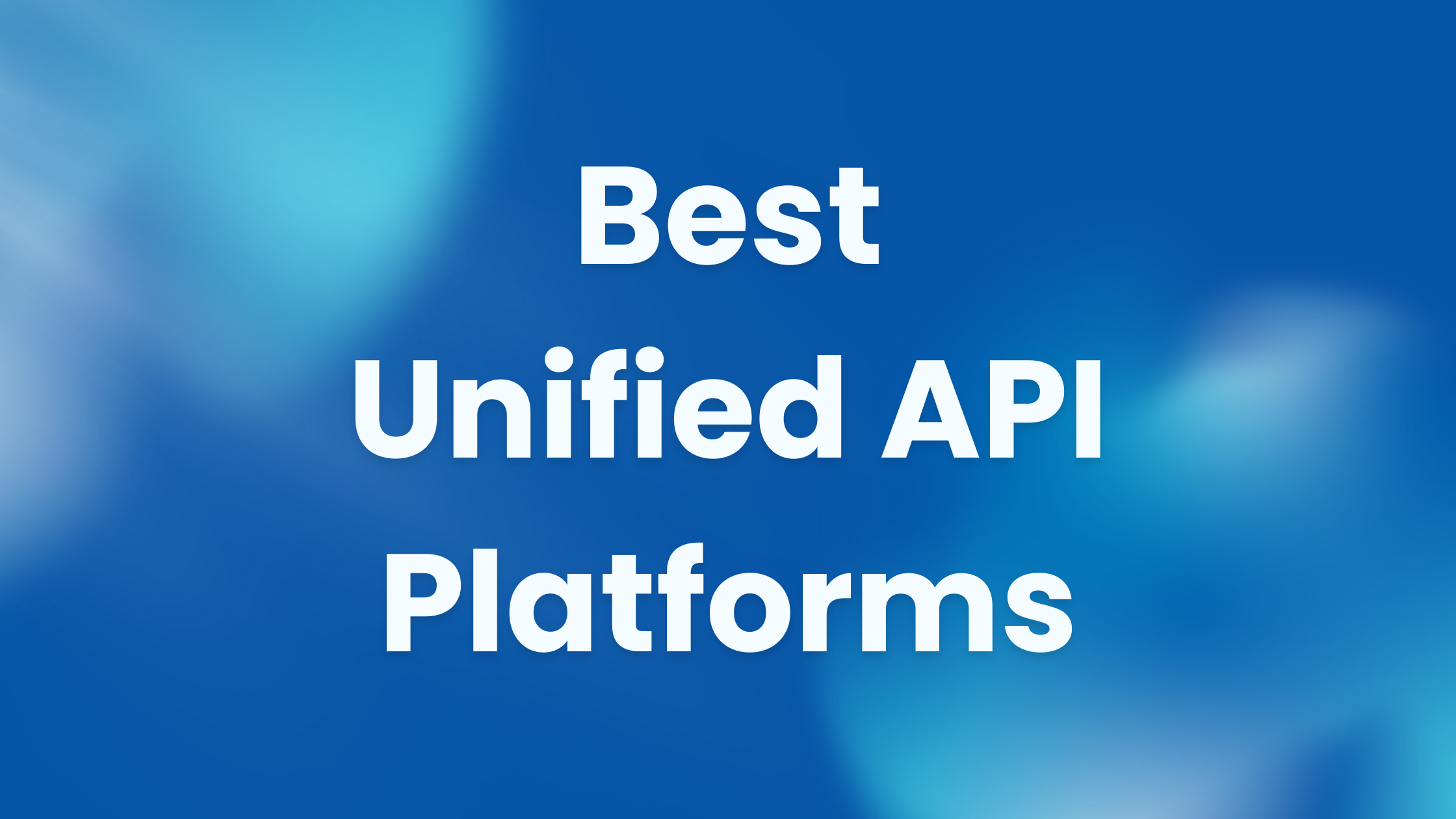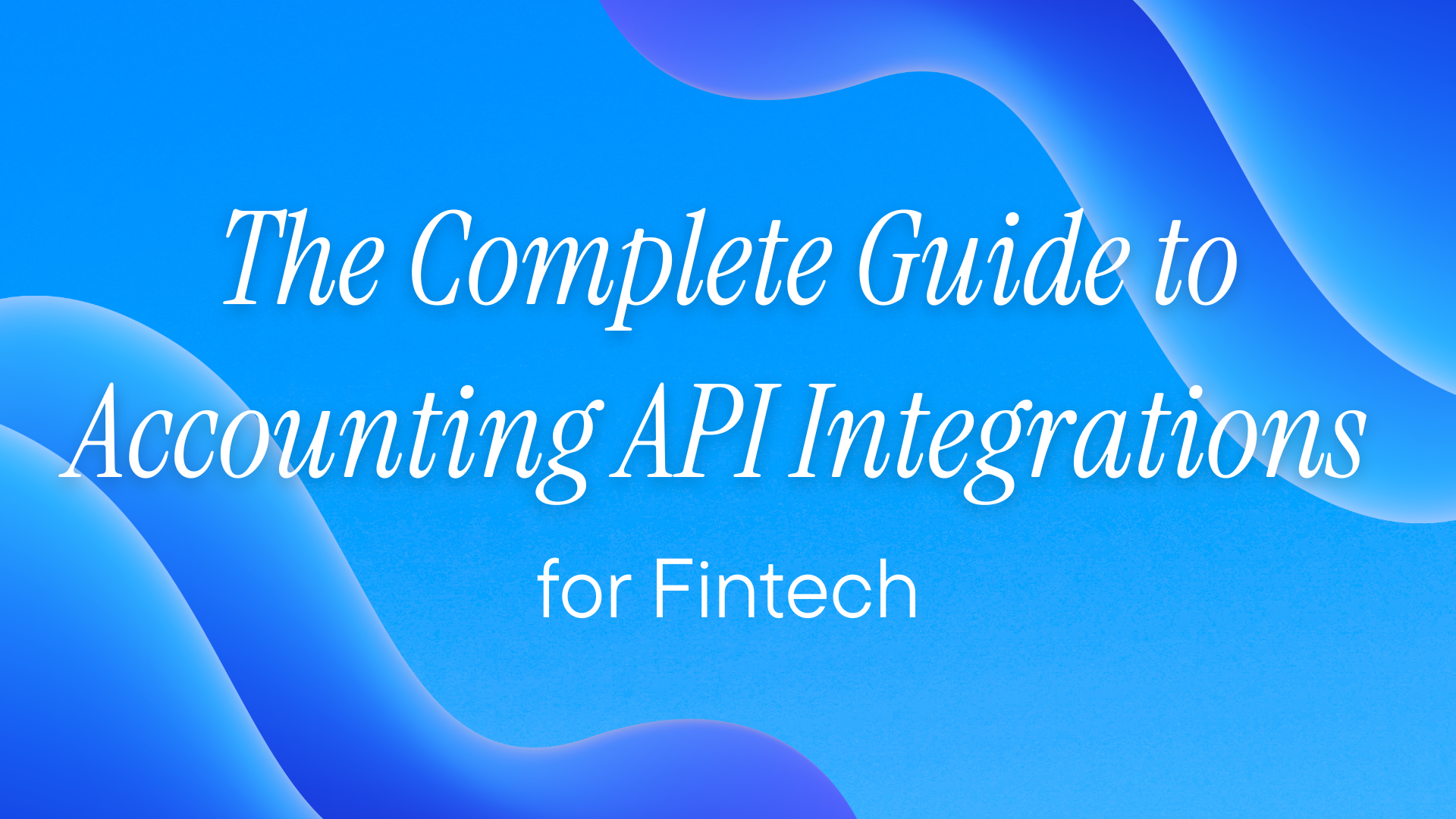Building integrations is one of the most painful parts of launching and scaling a software as a service (SaaS) product. Every client comes with a different stack, requiring custom APIs, auth, and data mapping; for example, an HR company might want tools like QuickBooks, Xero, and Lever. This can often be an unscalable burden depending on your team size.
Trying to build a product while maintaining dozens of integrations and keeping up with the constant churn of third-party APIs is a recipe for burnout and falling behind on customer requests. You can get stuck in a cycle of ad hoc builds, weekly API changes, and mounting support tickets. If this sounds familiar, you should consider a Unified API to transform your approach.
A unified API abstracts multiple third-party APIs in a particular category (like HR, CRM, or accounting) into a single normalized API. Instead of learning Salesforce's REST patterns, HubSpot's quirky authentication, and QuickBooks' XML responses, you build against one consistent interface.
Here's why this matters more than you might think:
- Time savings are exponential, not linear. Each custom integration doesn't just take weeks or months to build; it requires ongoing maintenance as APIs change, authentication tokens expire, and edge cases emerge.
- Customer expectations have shifted. Modern B2B buyers expect integrations to "just work." They don't care that Xero handles webhooks differently than QuickBooks. They want their data to flow seamlessly, and they want it yesterday.
- Integration debt compounds quickly. Like technical debt, integration debt gets exponentially more expensive to fix as it accumulates. What starts as "We'll build a quick connector" becomes a maintenance nightmare that slows your entire product roadmap.
This roundup compares the top unified API platforms, highlighting essential trade-offs for successful implementation.
1. Apideck

Apideck stands out in the unified API space for one critical architectural decision—it doesn't cache your data. While this might initially seem like a technical detail, it fundamentally transforms how you can use their platform, enabling genuinely real-time integrations that other platforms simply cannot match.
Key Strengths
Apideck offers several advantages that set it apart from competitors in the unified API space, particularly for organizations requiring real-time data and comprehensive integration capabilities:
- Real-time data access: Apideck retrieves data directly from downstream APIs without caching. This eliminates the fifteen- to thirty-minute delays common with competitors, making it ideal for time-sensitive operations—like employee terminations or sales updates—that require immediate synchronization.
- Comprehensive create, read, update, and delete (CRUD) support: Unlike platforms that focus primarily on data reading, Apideck supports full CRUD operations across most of its 190+ connectors. This matters significantly when you're building features that need to write data back to source systems, enabling truly bidirectional workflows.
- Usage-based pricing: Most unified API platforms use tiered pricing that forces you to pay for connectors you don't use. Apideck's call-based pricing means you only pay when your customers use integrations, potentially saving thousands monthly and creating predictable scaling economics.
- Security and compliance: The no-storage approach provides genuine security advantages. There's no third-party database of your customer data to worry about, which simplifies System and Organization Controls (SOC) 2 compliance. This also reduces your attack surface, which is a critical consideration for enterprise customers and regulated industries.
- Sandbox environment: Apideck provides a sandbox for safe testing and development, allowing you to build and test integrations without affecting production systems or customer data.
- Custom field mapping: Different platforms may provide information using varying formats and methods, and Apideck allows you to unify these disparities, ensuring consistent data flow regardless of source system variations.
Limitations
While Apideck offers significant advantages, there are a few considerations to keep in mind when evaluating whether it's the right solution for your integration needs:
- Manageable learning curve for complex mappings: The flip side of comprehensive CRUD support is some initial complexity. If you need to map complex data relationships across different platforms, you may spend more time initially understanding their data models than you would on more opinionated platforms. However, this investment typically pays off in greater flexibility and long-term maintainability.
- Source-dependent response times: Since Apideck hits source APIs directly, response times can vary based on the underlying platform's performance. If QuickBooks is having a slow day, your integration might be affected. That said, this approach ensures you're always getting the freshest data possible, which is critical for real-time business operations.
Technical Considerations
When implementing Apideck in your technology stack, there are several technical aspects to keep in mind that will affect your development process and ongoing operations:
- Direct API approach: Apideck's no-caching approach means you'll want to implement appropriate error handling and retry logic in your application to manage potential downstream API outages or rate limiting. This architectural choice delivers significant benefits in data freshness while enabling a flexible implementation.
- Authentication management: While Apideck simplifies OAuth flows significantly with its Vault product, you'll still need to guide your customers through connecting their third-party accounts. This requires thoughtful UX design in your application, but Apideck provides extensive developer tools to streamline this process.
Tial and Evaluation
Apideck provides a trial option that allows teams to test the platform before committing. The trial includes full sandbox access with test credentials for all supported platforms, enabling developers to validate integration requirements and build prototypes without initial financial commitment. No credit card information is required upfront, reducing friction in the evaluation process. Trial users can access core capabilities including webhooks, custom field mapping, and the complete connector library to properly assess whether the platform fits their needs.
The trial environment uses real API endpoints in sandbox mode rather than mock data, providing realistic testing conditions that give confidence about production behavior. This structure can be useful for teams that need to validate technical requirements before budget allocation or want to demonstrate integration capabilities in early development stages.
Best For
Apideck is particularly well suited for the following:
- B2B SaaS companies that need real-time data synchronization across multiple verticals
- Teams building write-heavy integrations (not just reading data)
- Products where integration performance and data freshness directly impact user experience
- Companies prioritizing security and compliance in regulated industries
- Fast growing startups that don't want to be limited by the number of customers that can enable integrations
- Organizations with unpredictable integration usage patterns requiring flexible scaling
- SaaS platforms offering free plans or trials that include integrations. Where performance and scalability at low or no cost is critical to conversion and retention in early user journeys.
2. Merge

Merge has gained significant traction among fast growing startups, primarily because of its broad connector offering and initial focus on HRIS and ATS. It is being used across many different verticals, including recruiting. However, this polish comes with substantial trade-offs that aren't immediately obvious to many teams until they're deeper into implementation.
Key Strengths
Merge distinguishes itself with a developer-first approach that prioritizes ease of implementation and comprehensive documentation, making it attractive for teams looking to launch integrations quickly:
- Good documentation: Merge has invested in their API documentation. It includes interactive examples, clear error messages, and comprehensive SDKs in multiple languages. Their onboarding process features guided tutorials with step-by-step integration walk-throughs, and a developer dashboard that shows real-time integration status.
- Robust sandbox environment: Their testing environment mirrors production behavior, which is rarer than it should be in the unified API space. You can build and test workflows without touching production systems.
- Webhook reliability: Merge's webhook system is designed with retry logic and delivery tracking. This matters when building real-time features.
Limitations
Despite its polished developer experience, Merge has several significant constraints that should be factored into your decision-making process:
- Caching delays: Merge's architecture includes a caching layer between your application and source APIs. While this improves performance and provides historical data access, it introduces systematic delays ranging from one to twenty-four hours, depending on the plan and platform. For real-time applications or time-sensitive operations, this can be a critical deal-breaker.
- Expensive: Merge's pricing appears competitive initially but can become challenging as you grow. Its "standard" tier severely limits API calls, and advanced features like custom field mapping are locked behind enterprise pricing. Many teams find themselves pushed into enterprise pricing faster than expected, resulting in unpredictable budget impacts. Regular price hikes are not uncommon.
- Limited CRUD operations on lower tiers: Full create/update/delete functionality is restricted on standard plans. If you're building anything beyond read-only integrations, you'll need to budget for enterprise pricing, which significantly affects the total cost of ownership.
Technical Considerations
From a technical implementation standpoint, there are several factors that developers should be aware of when working with Merge:
- Data model rigidity: While clean, Merge's normalized data models can sometimes lose important context from source systems. Custom fields and platform-specific features don't always map cleanly.
- Unified Writes with field-level validation: Merge's Unified Writes feature allows developers to write data across multiple third-party platforms through a single API. This capability is particularly beneficial for applications that need to push data to various systems without implementing separate integrations for each.
Best For
Merge is an excellent choice for the following:
- Companies with large budgets prioritizing fast implementation over real-time data
- Teams with primarily read-heavy integration needs
- Companies that value multiple Unified API categories
3. Codat

Codat has carved out a specific niche in the Fintech space—it's laser-focused on financial and accounting data. If you're building fintech applications or need deep integration with accounting platforms, Codat offers depth in this vertical which comes with an enterprise price tag. If you need anything else, you'll have to look elsewhere.
Key Strengths
Codat excels in financial-data integrations with specialized capabilities that enable banks and financial institutions to handle the complexities of accounting systems:
- Financial-data expertise: Codat understands accounting data in ways that generalist platforms don't. It handles scenarios like multicurrency transactions, tax calculations, and accounting period adjustments, which would challenge other platforms.
- Sophisticated data normalization: Its data-normalization approach can take a complex NetSuite transaction and present it in the same format as a simple QuickBooks entry while preserving the underlying business logic.
Limitations
While Codat excels in financial-data integration for specific use cases like spend insights, it comes with substantial constraints that determine whether it's a suitable choice for your application:
- Limited use cases: If you need CRM, HR, or any nonfinancial integrations, Codat can't help you. This makes them unsuitable for most B2B SaaS platforms that need multi-vertical integration capabilities, requiring you to maintain multiple integration providers and significantly complicating your integration architecture.
- Complex pricing structure: Codat's pricing gets expensive quickly for high-volume applications. Its usage calculations include data refreshes and webhook deliveries, which can add up faster than expected, making budgeting challenging and potentially leading to unpredictable monthly costs.
- Data model rigidity: While clean, Codat's normalized data models can sometimes lose important context from source systems and can hurt DX.
- Limited real-time capabilities: While Codat offers webhooks, their architecture relies primarily on periodic data synchronization rather than real-time updates. For financial reporting, this is usually acceptable, but it fundamentally limits use cases requiring immediate data consistency, creating potential business logic challenges.
Technical Considerations
From an implementation perspective, Codat presents several technical aspects that developers should evaluate before committing to the platform:
- Data-model complexity: The flip side of sophisticated financial-data handling is complexity. Codat's data models require significant domain knowledge to implement correctly.
- Integration maintenance: While Codat handles the technical maintenance of accounting platform connections, you still need to understand the business logic differences between platforms to build robust applications.
Best For
Codat provides specialized value for the following:
- Fintech companies needing deep accounting system integration
- Applications focused exclusively on financial-data analysis
- Teams with strong accounting domain expertise
4. Workato

Workato isn't really a unified API platform—it's an enterprise automation platform that happens to have integration capabilities. This fundamental distinction significantly impacts how you would use it compared to purpose-built unified API solutions.
Key Strengths
Workato offers a different approach than pure unified API platforms, with capabilities geared toward complex enterprise automation needs:
- Enterprise workflow automation: If you need to build multistep workflows that span multiple systems, Workato can handle scenarios like "When a deal closes in Salesforce, create an invoice in QuickBooks, update the customer record in the CRM, and send a notification to Slack."
- Business user empowerment: Workato's low-code interface allows nontechnical team members to build and modify integrations. For large organizations, this can reduce IT bottlenecks.
- Recipe ecosystem: Workato's library of prebuilt "recipes" (workflow templates) can accelerate implementation for some common integration patterns.
Limitations
While Workato offers automation capabilities, there are critical drawbacks to consider when evaluating it against more focused unified API solutions:
- Massive overkill for simple integrations: If you just need to sync contact data between your app and a CRM, Workato is like using a firehose to water a house plant. The complexity and cost don't justify the capabilities for straightforward integration needs, resulting in unnecessary overhead and inflated implementation costs.
- Enterprise pricing: Workato's pricing starts in the thousands per month and scales up steeply. For most SaaS startups and midmarket companies, it's economically prohibitive compared to dedicated unified API platforms that offer more efficient and focused integration solutions.
- Not developer-friendly: While Workato offers APIs, it's primarily designed for business users and workflow builders, not software developers building product integrations. This can create significant friction for engineering teams accustomed to more developer-centric tools and can extend development timelines unnecessarily.
Technical Considerations
For technical teams evaluating Workato, there are several important architectural and implementation factors to consider:
- Performance overhead: Workato's workflow engine adds latency compared to direct API calls. For real-time integration needs, this can be problematic.
- Vendor lock-in: Moving off Workato requires rebuilding your integration logic from scratch. The platform's proprietary workflow format doesn't translate to other tools.
Best For
Workato is most effective for the following:
- Large enterprises needing complex workflow automation
- Organizations with dedicated integration teams
- Companies where business users need to modify integration logic
5. Unified.to

Unified.to represents the newer generation of unified API providers. The company is moving quickly and targeting startups with competitive pricing. However, being newer means the service lacks many of the enterprise-grade features and mature infrastructure of established providers.
Key Strengths
As a recent entrant in the unified API space, Unified.to offers some advantages for early-stage companies and developers looking for simplicity:
- Aggressive pricing: Unified.to undercuts established competitors on price, which may appeal to cash-strapped startups. Its entry-level pricing is accessible for early-stage companies.
- Fast connector development: It appears responsive to connector requests and can deliver new integrations. If you need a niche platform integration, it's worth considering.
- Simple API design: Its API surface is simpler than that of more mature platforms. This means less flexibility but potentially easier implementation for basic use cases.
Limitations
While Unified.to offers accessibility for startups, its position as a newer platform comes with significant drawbacks that may give pause to companies building mission-critical integrations:
- Limited enterprise features: It has basic SLA guarantees, minimal compliance certifications, and no SSO. This might work for startups but presents serious obstacles for enterprise sales and security-conscious organizations requiring robust infrastructure.
- Smaller connector library: It has substantially fewer connectors than established competitors. Check its current list carefully against your needs and its future expansion plans as you may quickly outgrow its ecosystem.
- Support limitations: Being a smaller team means having less comprehensive support infrastructure. Response times can be slower, and complex technical issues may take longer to resolve, which can be problematic in production environments where real-time support is essential.
Technical Considerations
When implementing Unified.to in your development stack, these technical factors should be carefully evaluated:
- API Stability As a newer platform, it's still iterating on its API design. Expect more breaking changes compared to mature platforms.
- Documentation quality: It's functional but not as comprehensive as those of competitors like Merge or Apideck. Plan for more trial and error during implementation.
Best For
Unified.to is ideal for the following:
- Early-stage startups with tight budgets
- Teams needing specific connectors that other platforms don't support
- Simple integration use cases without enterprise requirements
6. Kombo
Kombo focuses exclusively on HR, ATS and payroll systems, and this specialization shows in both its technical capabilities and data-model sophistication.
Key Strengths
Kombo's focus on HR and ATS systems has allowed them to develop specialized capabilities that make their service a strong choice for human resources integrations:
- Comprehensive HR data models: Kombo understands HR data—org charts, employment history, benefits enrollment, payroll deductions—in ways that generalist platforms may not. Its data normalization preserves important relationships and context.
- Write operations for HR systems: Unlike many unified APIs that focus on reading data, Kombo enables writing back to HR systems. This is useful for applications that need to update employee information, manage benefits, or handle organizational changes.
- Compliance and security: HR data requires special handling for privacy and compliance. Finch has built-in support for data-residency requirements and provides audit logs for sensitive operations.
Limitations
Despite Kombo's capabilities in HR and ATS integrations, there are substantial constraints to consider when evaluating it as part of your integration strategy:
- Zero flexibility beyond HR: If you need any non-HR integrations, Kombo can't help you at all. This makes it unsuitable for most B2B SaaS platforms that need multivertical capabilities, forcing you to maintain multiple integration providers and creating significant technical overhead.
- Higher per-integration cost: Because it serves a narrow market, Kombo's pricing per connector tends to be higher than generalist platforms. While the depth of features might justify this for HR-focused applications, it creates a considerable cost burden if you only need basic data synchronization.
Technical Considerations
From a technical implementation perspective, Kombo offers several specialized capabilities that developers working with HR data will appreciate:
- Token management: Kombo handles the complexity of HR system authentication, including multifactor authentication and token refresh logic that varies significantly between platforms.
- Data consistency: HR systems often have complex data validation rules. Kombo's API design helps prevent data integrity issues that can break payroll processing or compliance reporting.
- Webhook reliability: HR data changes are often time-sensitive (think employee terminations or salary changes). Kombo's webhook system is designed for reliability with proper retry logic and delivery confirmation.
Best For
Kombo is the optimal choice for the following:
- HR technology platforms and people analytics tools
- Applications requiring write access to HR systems
- Companies in regulated industries with strict HR data-compliance requirements
Comparison: What Really Matters in Practice
While you're comparing these solutions, keep in mind that every unified API platform has inherent limitations you'll need to address. Even the most comprehensive platforms will have connector coverage gaps requiring some custom development (typically 10 to 20 percent of your integration work), and all will face challenges with messy real-world data that demands extra implementation time for edge cases. Additionally, be prepared for potential cost fluctuations during data migrations or bulk operations as API pricing can increase dramatically during these high-usage periods. With these common challenges in mind, here's how the major platforms stack up:
| Platform | Real-Time Data | Pricing Reality | Major Limitation |
|---|---|---|---|
| Apideck | ✅ True real time | Usage-based, scales efficiently | Manageable learning curve for complex mappings |
| Merge | ❌ Periodic sync. Frequency dependent on plan | Prohibitively expensive | Significant caching delays + limited CRUD |
| Codat | ❌ Periodic sync | Unpredictable high-volume costs | Strictly financial data only |
| Workato | ⚠️ Workflow dependent | Prohibitively expensive | Excessive complexity for most integrations |
| Unified.to | ✅ True real time | Startup-friendly but tiered | Immature connector ecosystem |
| Kombo | ❌ Periodic sync | Premium pricing | Exclusively HR and ATS systems |
Conclusion
The unified API landscape offers several mature solutions, each with unique strengths. Your optimal choice depends on specific priorities:
- Data freshness: Is real-time data access essential for your business processes?
- Integration breadth: Do you need capabilities across multiple verticals or categories?
- Development flexibility: How important is full CRUD support for your product roadmap?
- Security considerations: What compliance and data handling requirements must you meet?
- Scalable pricing: How will integration costs align with your growth trajectory?
As your product matures, seemingly optional requirements often become business-critical. What starts as a "nice to have" becomes essential when customers depend on your integrations for core workflows, especially regarding real-time data synchronization and robust security.
Implementing an integration strategy with the right unified API platform can help you move from constantly firefighting integration issues to having customers ask, "How did you build integrations so fast?" Instead of burning engineering cycles on integration maintenance, you can focus on features that differentiate our product. The most successful implementations prioritize platforms offering real-time data capabilities, comprehensive CRUD operations, and usage-based pricing that scales with your business. For modern SaaS applications where data freshness and integration reliability directly impact user experience, platforms that prioritize real-time operations and transparent scaling economics consistently deliver the most sustainable value.
Ready to get started?
Scale your integration strategy and deliver the integrations your customers need in record time.








